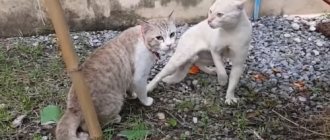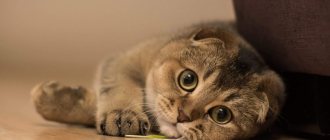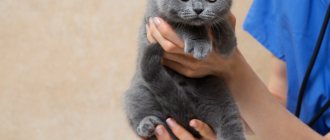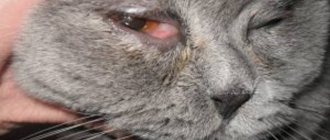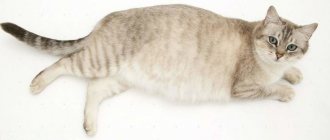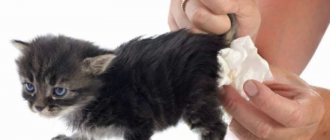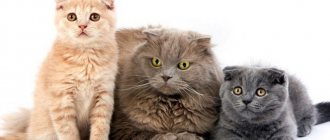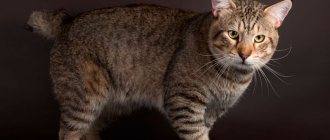Features of behavior and character of British women
When characterizing British cats, you need to understand that everything depends on their behavior. If you want to raise an animal, then you need to do this only up to a year, after which you won’t be able to change anything. Some owners complain about disobedience, not realizing that this is a consequence of poor upbringing . The British are proud enough that they will never ask a person for help. These are not the breeds that will cuddle or purr plaintively, trying to attract attention. These representatives will try to act independently.
While still babies, British kittens easily learn to use the litter box. The aristocratic breed does not allow them to shit wherever they have to. If you look at how a cat sleeps, you can involuntarily smile: on its back, in a ball, with its hind legs outstretched, on its side. The places to sleep are no less fun. Sometimes fluffy hides in places where you wouldn’t even think of looking for him - in a laundry basket or among soft toys. The habits of the British dog are often unpredictable, but this is dictated by the breed and some inherent instincts.
Owners' opinion
Domestic British cats. Character, reviews:
- For many people, the waywardness of the British does not seem to be a problem. You can get used to it. If you are patient, show love and care, the cat will reciprocate;
- Many people like the ease of care associated with natural cleanliness. Still, when your corners, sofas and slippers remain intact, it’s nice.
So, according to most owners, this cat is a gift from fate. She is kind, calm, and adequate from a very early age. Fortunately, the character of any purebred British cat is quite acceptable even for a family with a small child.
4.4 / 5 ( 308 votes)
Character of British cats
Multifaceted and contradictory - this is how the character of “aristocratic animals” can be briefly described. Representatives of the British differ significantly in disposition from other cat breeds.
They never:
- They won’t sit in the kitchen and yell for food to be poured into them.
- They will not ask to be held by their owner, and will not sit on their laps if you take them by force.
- They won’t rub against their owner for days.
Cats spend all their free time to their advantage and do what they want. The British are independent and proud.
Cleanliness
Cleanliness is something that cannot be taken away from British women . This is inherent in them, this is what their mother cat teaches them. Purrs can lick themselves for hours without getting tired, and until the procedure is completely completed, they will not switch to another activity.
Representatives of this breed will not allow themselves to tear up furniture if they have a nail clipper for this purpose. Having shown the animal a couple of times the place reserved for sharpening nails, they will remember it forever.
Mind
The British are not short on intelligence. Tangles understand everything almost the first time. The only task that lies with the owner is to initially show the animal where to go to the toilet, where is the place to eat, where is the lounger, and the like.
Amenability
The British Shorthair cat gets along well with any animal, be it dogs, cats, parrots, iguanas and other representatives of the “wild world”. If a Briton doesn’t like something, he will not tolerate the disgrace that is happening next to him, but will turn around and proudly leave.
The same applies to children: when kids don’t touch cats, they don’t pay attention to them. Otherwise, the felines get up and go home.
Stubbornness and touchiness
All cats are stubborn in their own way, and the same applies to the British. Speaking about the character of British cats, it would not be out of place to say that they do everything according to their own wishes and at their own discretion. If a furry friend doesn’t want to lick him out of his house to play in the cold season, for example, then you can’t force him to do it. Of course, you can shake the animal out by force, but it will immediately find a place where no one will disturb it.
As for touchiness, pets have plenty of this. If the owner scolded the four-legged animal undeservedly or suddenly raised his hand to it, one should expect trouble. The cat will not forgive this, so it will sit in the shelter for a long time, and then refuse to eat.
Important! To avoid having to scold an adult cat for the slightest misdeeds, kittens should be taught order from childhood, instilling in them certain skills.
Restraint
The character of British cats is such that they do not like to show tenderness, love or resentment towards people, and especially in front of strangers. When an animal is offended, it will lick itself for a long time, thus relieving stress. A joyful bundle can make a circle of honor around a person, and then climb into its house or go to another favorite place. Only some representatives of the British can be gentle and loving, but this is due to the merit of the person who taught the animal to do this from childhood.
Playfulness
A cat's life consists of more than just sleep and food. Games play a big role for felines. The British are big fans of fooling around, of course, within the limits of what is permitted. An exception may be adult cats, although they can sometimes be caught doing this.
Kittens are overly selective in their games. What they like most is hiding and emerging from their ambush. Attacking is another fun activity for them. In this way, they try to imitate adult representatives who, in a playful way, teach their children to attack and also defend themselves. Sometimes, when kittens are tired, they pretend to sleep so that they can be left for a while. And after a short period of time, they pick up, raising their tail, and begin to chase their prey again.
Animals associate some toys with real prey - mice or rats. Swinging objects may remind four-legged birds of birds or butterflies that they so want to catch. At the same time, animals understand perfectly well that when playing, they are not hunting anyone, so they behave somewhat differently. When tracking real prey, the pets are serious and attentive, sometimes the cats are angry, but you can’t do without this when hunting. At home, they rarely release their claws, and their bites do not hurt at all.
Knowing the character of the British, many breeders recommend that owners set up a small corner for their pets, throwing small toys and strings there. If a person does not have time to play with his four-legged pet, then he needs to be given the opportunity to occupy himself independently.
Important! Cats who are not given time and who do not have toys begin to play mischief: jumping on furniture, hanging on curtains, knocking down everything in their path. And this is not the fault of the animals, but of the people who did not provide their pets with everything they needed.
History of the British shorthair breed, briefly
One of the oldest cats in England is the British Shorthair and has Roman roots. To protect food supplies from rodents, Roman troops took cats with them. When the Romans invaded England, the cats colonized the area and became common street cats for centuries.
The first British breeder in the late 1800s was Briton Harrison Ware. He domesticated the British street cat and through selective crossbreeding and a breeding program created the British Shorthair cat. The first professional exhibition was held in London on July 13, 1871 at the Crystal Palace; blue color was then considered the only correct color for the British.
During World War II, the breed almost ceased to exist. To preserve their existence, the remaining bloodline cats after the war were crossed with other breeds, including domestic shorthair, Persian, and Russian Blue.
The American Cat Association was the first to register the breed in 1967. After the International Cat Association - 1979, Association of Cat Fanciers - 1980.
British Shorthair, appearance
The British are stocky, harmoniously built, broad-chested, and at shows they are judged according to the breed standard.
There are no ideal standards; breeders strive for perfection in their work.
At exhibitions you can see several types of British cats:
- The old classic - quite a lot of such animals are born, they are bought by novice lovers, and not by competent breeders. What do they look like? The animals have a slightly elongated body, close-fitting fur, high thin limbs, a narrow head with a weakly pronounced transition from an unfilled flat forehead to a long nose, narrowed to the lobe;
- Modern - squat and broad-chested, the head has smooth outlines from all angles, plush fur, a detailed description in the standard is described here.
- Extreme - characterized by an “exoticness” that is unnecessary for British cats, which leads to breathing problems, malocclusions, and excessive lacrimation due to an abnormality in the structure of the tear ducts - this is a dead end in the development of the breed.
British Longhair | British Longhair
A variety of British cat with long hair, separated into an independent breed. This breed appeared as a result of crossing a Persian and a British cat. The gene responsible for long hair is recessive, so a long-haired kitten can only be born from a pair of male and female cats carrying this gene. If one of the parents does not carry the gene for long hair, then all kittens in the litter will have short hair.
photo of british longhair
British Longhairs are also assessed according to the standard, more details here.
Characteristics: fluffy Britons, like shorthaired ones, have a massive, squat body with a large head, the main difference is their hair. It should be of medium length, smooth and very dense, with a sufficient amount of undercoat. Due to the thick undercoat, the coat is separated from the body. “Pants” and “jabot” are desirable. The tail should be thick and fluffy to highlight the beauty of the cat. The texture is quite coarse and crisp, but softer than the British Shorthair.
photos of lilac british longhair cat
The British cat is always straight-eared! Fold cannot be British, it is either a mixed breed (not purebred) or a Scottish Fold. Straight is also a type of Scottish.
Eye color corresponds to coat color: blue, yellow, copper-orange, green; whites can have different colors - heterochromia.
Coat color: color point, red, chinchilla, tabby, black, cream, blue, white, lilac, chocolate, tortoiseshell, cinnamon, bicolor.
Psychology of British cats
The character and behavior of a British cat can be very different. However, the key determining factor is the animal's mood. The owner himself can spoil it or, on the contrary, improve it. Despite the fact that the pet is self-sufficient and can be alone for a long time, it cannot be ignored.
Some owners of four-legged animals complain that with the appearance of a child or another animal in the family, the British change, become closed and touchy. This happens because no one pays attention to the furry friend; they found a replacement for him. The British actually become very attached to their owners, but only because of their disposition do they not show it. However, this does not mean that animals can live on their own; they also want to be handled and noticed.
Idioms about tea
cup of tea - something preferred, desired, loved
Lit. "someone's cuppa"
Something pleasant, familiar, to taste:
Teaching children to read is just my cup of tea. — Teaching children to read is mine.
not one's cup of tea - something alien
Lit. "not anyone's" cuppa"
“Not my thing”, “not mine”:
Going to church, Mary said, was not her cup of tea. “She doesn’t like going to church,” said Mary.
tea party - 1) crazy party 2) simple and pleasant event
Lit. "tea party"
1. Loud, noisy, “crazy” party: There was a loud tea party going on in the pub when Jess came in. — When Jess entered, there was a noisy and riotous party in the pub.
2. An easy and pleasant event that does not cause fear or anxiety: The test was a real tea party. No sweat. — The exam was easy. No tension.
not for all the tea in China - not for anything in the world
Lit. “not for all the tea in China”
Not for any price, not for any price, never in life:
I wouldn't give up my car, not for all the tea in China. “I won’t give up my car for any wealth in the world.”
tempest in a teapot - storm in a glass of water
Lit. "storm in a teapot"
Also tempest in a teacup (“storm in a teacup”), tempest in a glass of water (“storm in a glass of water”), much ado about nothing (Shakespearean, “much ado about nothing”); in the British version - storm in a teacup. Overreaction to a minor event:
All that because a handful of the thousand invited guests didn't show up? What a tempest in a teapot! - And all this because a handful of thousands of invited guests did not show up? What a storm in a teacup!
Habits
The bright character traits of the British directly influence their habits. Some people believe that since animals belonging to the presented breed are quite obedient, then they cannot do any bad things, but this is not so.
Common negative habits include:
- Scratching and biting hands.
- Throwing objects off surfaces.
To somehow compensate for this, many people want to know how the British are doing with catching mice, and this is a completely different matter.
Catching mice
British cats are often called clumsy. It is impossible to argue with this, but this does not prevent them from being excellent rat-catchers and mouse-catchers. If you believe history, the French always took cats of these breeds with them on voyages so that they would keep an eye on supplies and leave no chance for rodents to profit from various delicacies.
It is rare to find mice in modern apartments, so even with a strong desire, it would be difficult for cats to try to hunt someone. Another thing is animals that live in private sectors and in dachas. Pet owners have repeatedly noted that cats are very agile and excellent hunters. Some people believe that since they managed to cope with the rodent, they should definitely feast on it, but this is not so. Representatives of felines catch mice and rats for fun, they do not even understand that this is food that should be eaten. The reason lies in the character of the British cat, which was taught from childhood to a place for food. Having played enough, the animal leaves its prey and goes on about its business.
Biting and scratching
Scratching and biting the hands of their owners is a favorite activity of four-legged animals. At the age of three or four months, the kitten begins to bite the hands and sometimes the legs of a person. This is directly related to the change of teeth in animals. There is no need to think that such a habit will go away on its own. If the situation continues for a month, the animal will realize that it is possible to do this and in the future you will not wean it from it. At the same time, there is no need to try to beat the baby or shout at him; it is not his fault that his teeth itch. It needs to be done much simpler - during an attack, put a soft toy or mouse on your hand, which will interest the pet and become its favorite victim in the future.
Dropping items
Throwing objects off the table is an equally interesting activity. It can be anything, from a pen to a flower pot. Among the main character traits, self-indulgence is not listed among the British, but for them it is not self-indulgence, but curiosity. Cats are very interested to see how the object will fly down and what will happen to it after. If you want to stop this, then you should either sprinkle the surface with a pungent odor that animals cannot tolerate, or make the surface so that the pet does not have the slightest chance of climbing on it. At the same time, you must not forget about toys for your pet so that he does not have to get bored.
About activity
The character of British kittens, like cats, can actually be reserved and sometimes even cold, but this does not in any way affect their activity. The British sleep a lot, but in their free time they will do what they want: run, jump, play. The exception in this case is only older representatives of the breed. Pets that have access to the street are more active. They are interested in everything around them: leaves, butterflies, flowers, so cats can spend hours on end outside. If there are several cats in the family, then additional activity will be provided. This is very good, since active animals have much fewer health problems.
Important! To prevent your cat from lying around in the apartment, you should play with him from time to time and offer him some options for useful ways to spend his waking hours.
Description
The external characteristics of these animals are as follows:
- A rounded head, large cheeks, a straight and short nose, low-set small ears, large open eyes, most often golden in color.
- A muscular body with wide bones, a wide torso and a massive back, short limbs, the weight of females is on average five kilograms, and in males it can reach up to eight.
- Thick shiny fur. There are short-haired and long-haired Britons, the former have plush and delicate fur, the latter have a good undercoat and gorgeous pubescence of the tail, collar and panties.
- Two or one color, the most common are black, blue white, lilac, cream and red cats. There are also tabby and ticked specimens.
If an animal has too pronounced antler caps, a long hooked nose, or sharp facial features, this is considered a fault.
Do the British have bad habits?
It is believed that aristocrats do not and cannot have bad habits. Of course, the behavior of British cats may sometimes not fit into the generally accepted framework of these peculiar animals, but in any case, representatives of other breeds should be compared to them. This is not entirely true.
There are several bad habits of British cats that you should be aware of:
- Using the owner's personal belongings as toys, as well as items that cannot be used for these purposes. We can talk about jewelry, tubes of creams, sweets. If there is no fear that the animal will take these items somewhere, then you should not take them from him. The kitten will frolic a little and will lose all interest in what was just found. Otherwise, it is better to pick up the item, but be sure to exchange it for any other one.
- Some animals love to climb inside bags, boxes, packages and cabinets. It is difficult to find an explanation for this, but this does not mean that the pet will immediately stop doing this. In this case, you can also do it in two ways - allow it to be done or try to wean it off by replacing one activity with another.
Britons may actually be skittish animals, but they are also very intelligent, playful and active pets.
Did you like the article?
